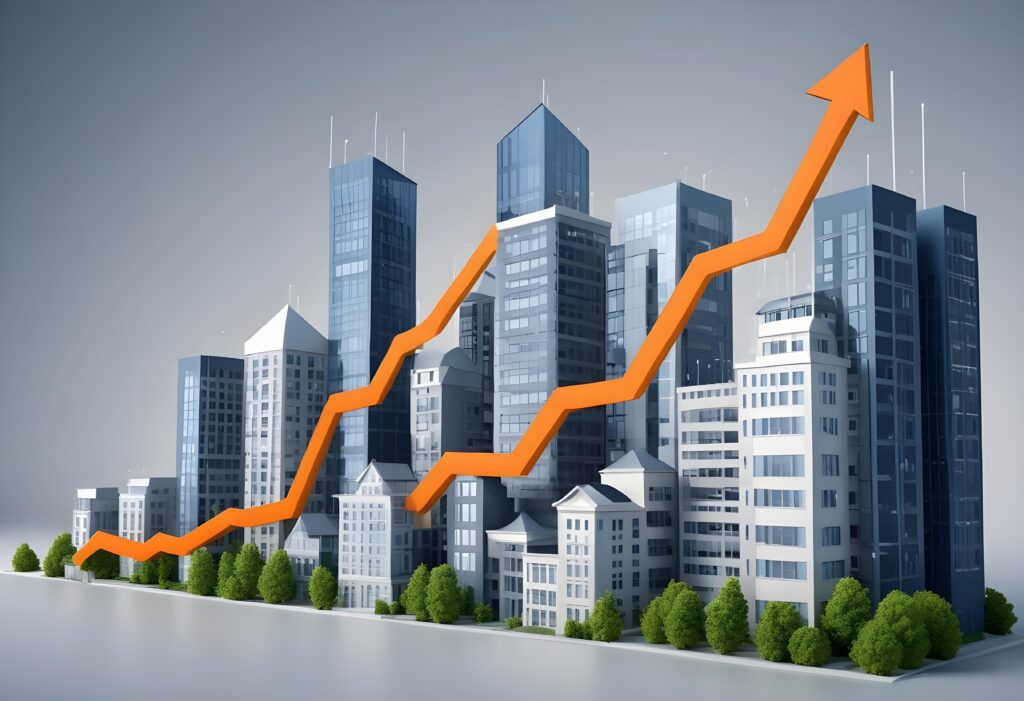
One of the main pillars of the world economy is the real estate industry, which includes the purchase, sale, rental, and development of land and structures. It is essential to the development of infrastructure, economic expansion, and employment opportunities. Communities and towns are shaped by the real estate market, which affects everything from residential to commercial real estate.
Due to government initiatives, rising disposable incomes, and fast urbanization, the Indian real estate market has experienced extraordinary expansion in recent years. A wide variety of property types, including residential, commercial, industrial, and retail areas, define this industry. Despite obstacles including economic volatility and regulatory requirements, the industry nevertheless makes a sizable contribution to the nation’s GDP and presents profitable investment opportunity.

Indian Real Estate Market Growth
➡️ The real estate market is expected to increase from Rs. 12,000 crore (US$ 1.72 billion) in 2019 to Rs. 65,000 crore (US$ 9.30 billion) by 2040. By2025, the real estate sector in India is expected to contribute 13% of the country’s GDP, having grown from US$ 200 billion in 2021 to US$ 1 trillion by 2030.
➡️By 2047, the real estate industry in India is predicted to grow to a value of US$ 5.8 trillion, accounting for 15.5% of the country’s GDP, up from its current 7.3% share.
➡️With about 41 million square feet of retail developments expected to open in the top 7 cities between 2024 and 2028—projects ranging from planning to construction—India’s physical retail market is expected to see significant growth.
➡️Gross leasing in the top seven markets in India exceeded 60 million square feet for the first time, coming in at an astounding 62.98 million square feet, a significant 26.4% rise over the previous year. With gross leasing reaching 20.94 million square feet, the December quarter stood out as the busiest on record.
➡️In the first quarter of 2024, technology companies accounted for the largest percentage of lease activity (22%).Companies engaged in engineering and manufacturing (E&M) made up 13% of the total, while banks, financial services, and insurance made up 12%. Operators of flexible spaces grow by 48 percent, demonstrating their important contributions.

Government Initiatives
➡️The PM Awas Yojana Urban 2.0, which is included in Budget 2024–25, will provide homes for one crore urban poor and middle-class households with an investment of Rs. 10 lakh crore (US$ 120.16 billion), including Rs. 2.2 lakh crore (US$ 26.44 billion) in central aid over the following five years.
➡️Finance Minister Nirmala Sitharaman proposed an expansion of the PMAY-U flagship project to include 2 crore more houses, a boost to India’s affordable housing industry, in the interim budget for 2024–25.
➡️The Finance Ministry pledged to fund the PM Awas Yojana with Rs. 79,000 crore (US$ 9.64 billion) in the Union Budget 2023–24, a 66% increase over the previous year.
➡️The RBI’s announcement in October 2021 to maintain the benchmark interest rate at 4% significantly boosted the nation’s real estate market. It was anticipated that the low interest rate policy on home loans would stimulate demand for housing and boost sales during the holiday season in 2021 by 35–40%.
➡️The Union Budget 2021–22 extends the tax holiday for affordable housing projects till the end of the fiscal year 2021–22, as well as the tax deduction on housing loan interest up to Rs. 1.5 lakh (US$ 2,069.89).
➡️Over the last 24 years, from April 2000 to March 2024, the total amount of foreign direct investment (FDI) inflows into the nation has been $990.97 billion. In contrast, over the last 10 years, from April 2014 to March 2024, FDI inflows have totaled $667.410 billion, or nearly 67% of the total FDI inflow over the preceding 24 years.

Foreign Direct Investment
FDI inflow to India stood $45.14 billion in FY 2014–15, rising to $60.22 billion in FY 2016–17, and then reaching an all-time high of $84.83 billion in FY 2021–22.
➡️The nation received $70.95 billion in total FDI inflows in FY 2023–2024 and $44.42 billion came in the form of total FDI equity inflows.
➡️The top 5 nations for foreign direct investment (FDI) equity inflows into India during FY 2023–2024 are Mauritius (25%), Singapore (23%), USA (9%), Netherlands (7%), and Japan (6%).
➡️The top five states in terms of foreign direct investment (FDI) equity inflow for FY 2023–2024 are Tamil Nadu (5%), Delhi (13%), Gujarat (17%), Maharashtra (30%), and Karnataka (22%).
Read More About Foreign Direct Investment
Conclusion :
To sum up, the Indian real estate industry is seeing tremendous growth and has the potential to be a game-changer. Propelled by swift urbanization, increasing affluence, and strong government initiatives, the industry is expected to grow significantly, with projections indicating that it would reach an astounding US$ 5.8 trillion by 2047. In addition to being a major driver of India’s GDP, the growing retail, commercial, and affordable housing sectors also serve as a stimulant for the development of infrastructure and the creation of jobs. These developments are supported by substantial inflows of foreign direct investment.
The future of real estate in India promises to transform the urban landscape, raise living standards, and build sustainable communities as long as the government continues to fund programs like the PM Awas Yojana and the Smart City Project. With this growth trajectory, the Indian real estate sector is positioned to become a major contributor to the nation’s economic advancement in the years to come, offering investors, developers, and stakeholders attractive prospects.
Source: All Rights and Credit reserved to the respective owners


From Sky Gardens to Smart Rentals: The New Face of Real Estate in 2025



Emerging Real Estate Products Beyond 2BHK & 3BHK: New Concepts Reshaping Urban Living



